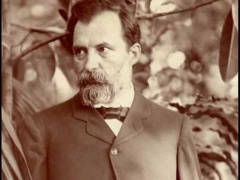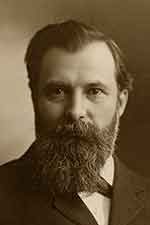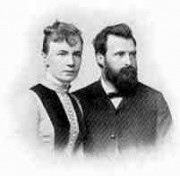Paul Carus
Dr. Paul Carus was a German-American writer and editor based in Chicago and La Salle, Illinois. As editor of the Open Court Publishing Company, he published hundreds of books and articles that were very influential in the fields of comparative religion, philosophy, science, and mathematics. His work with D. T. Suzuki in translating Chinese and Japanese texts was particularly noteworthy.
Dr. Carus wrote of the principle that guided his work:
The aim of all my writings centers in the endeavor to build up a sound and tenable philosophy, one that would be as objective as any branch of the natural sciences. I do not want to propound a new philosophy of my own but to help in working out philosophy itself, viz., philosophy as a science; and after many years of labor in this field I have come to the conclusion, not only that it is possible, but also that such a conception of the world is actually preparing itself in the minds of men. [1]
Early life and education
Paul Carus was born at Ilsenburg in Germany on July 18, 1852. His parents were Gustave Carus and Laura Krueger Carus. He studied at the Unviersity of Greifswald, completed a degree at the University of Strasbourg in 1876, and then a Ph. D. at the University of Tubingen. Paul emigrated to the United States around 1884 on the SS Grecian Monarch.[2] In 1887 he was invited by Edward C. Hegeler, to help educate his children in the classics at the family home in La Salle, Illinois.[3] Hegeler had come to the United States in 1857 and established a huge zinc mining business in central Illinois, along with other businesses and the Open Court Publishing Company in Chicago. Dr. Carus began contributing articles to a journal that Hegeler founded in 1887, and in 1888 was married to Hegeler's daughter Mary. On May 23, 1889, Carus became a naturalized American citizen at a court in New York.[4]
Open Court Publishing Company
The Open Court Publishing Company was founded in 1887 by Edward C. Hegeler, who remained as president when he brought Paul Carus on board as editor. The editorial office was located at 324 Dearborn Street in Chicago. The Open Court was published from 1887 to 1936, and a philosophical journal, The Monist, is a quarterly that was founded in 1888 and continues publication today under the auspices of Oxford University Press. The publishing company was also responsible for printing over 500 books on philosophy, science, mathematics, Eastern religions, Christianity, and other subjects.
1893 World's Parliament of Religions
Dr. Carus attended the World's Parliament of Religions in Chicago in 1893 and made a 30-minute talk on "Science as Religious Revelation." At that time he had the opportunity to meet many visiting representatives of Eastern religions, including some Theosophists:
He invited Dharmapala to give a lecture tour in the United States in 1896 and again in 1902-04. Carus also befriended the Japanese Zen master Soyen Shaku (1859-1919), whom he met at the Parliament.[5] After attending the Parliament Soyen traveled to Sri Lanka to study Pali and Theravada Buddhism for three years. At Carus's request Shaku also sent one of his students, Daisetsu Teitaro Suzuki, to the United States to translate Buddhist works for Carus's Open court Publishing Company.[6]
The Paul Carus Award for interreligious understanding was instituted in 2001 by the Council for a Parliament of the World's Religions following a donation by the family Dr. Carus. Since then it has been awarded at the Parliments in Barcelona (2004), Melbourne (2009), and Salt Lake City (2015).
Theosophical Society connections
Dr. Carus was certainly acquainted with Theosophists and with others who were indirectly connected to the Theosophical Movement, but he was never a member of any Theosophical Society. Theosophy was never a major interest to him. An article in the April 1904 issue of his journal The Monist (entitled "Mme Blavatsky" and authored by Henry Ridgeley Evans), was riddled with inaccuracies.[7]
Work with D. T. Suzuki
D. T. Suzuki (October 1870 – July 12, 1966) lived with the Carus family for eleven years in La Salle, Illinois, which became known as “Buddhism’s Gateway to the West.” Carus and Suzuki worked together on translations of texts from Chinese and Japanese languages. One notable work published in 1900 was Açvaghosha's discourse on the awakening of faith in the Mahâyâna, the Chinese version of the Sanskrit manuscript Mahayanasraddhotpadasastra by Asvaghosa. Other examples of titles published in Chicago by Open Court Publishing were:
- Suzuki, Daisetz Teitaro; Carus, Paul. Yin chih wen; the tract of the quiet Way, with extracts from the Chinese commentary. 1906. 48 pages. Translated from the Chinese. Available at Hathitrust and Internet Archive.
- Suzuki, Daisetz Teitaro; Carus, Paul. T`ai-shang kan-ying p`ien. 1906. Treatise of the Exalted One on response and retribution. Translated from the Chinese, with sixteen plates by Chinese artists, and a frontispiece by Keichyu Yamada. Available at Hathitrust.
- Suzuki, Daisetz Teitaro; Shaku, Soen. Sermons of a Buddhist abbot; addresses on religious subjects. 1906. Sermons of Soen Shaku translated from the Japanese by Daisetz Teitaro Suzuki.
Personal life
Dr. Carus and his wife Mary had six children named Edward, Gustave, Paula, Elizabeth, Herman, and Alwin. They lived in La Salle, Illinois, at 1307 Seventh Street, with his father-in-law Edward C. Hegeler. The house, now known as the Hegeler Carus Mansion, was built for Edward C. Hegeler in 1876. The Carus family also lived for a time at the Julius W. Hegeler I Home, another historic mansion in La Salle. That house was designed by Chicago architects Pond and Pond, who also designed the L. W. Rogers Building, headquarters of the Theosophical Society in America. Because Paul Carus brought Buddhist visitors to stay at his home, La Salle became known as “Buddhism’s Gateway to the West.”
Dr. Carus died at home on February 11, 1919. According to the Hegeler Carus Foundation website, "The legacy of Paul Carus is honored through the efforts of the Hegeler Carus Foundation, the Paul Carus Award for Interreligious Understanding by the Council for a Parliament of the World’s Religions (CPWR) and through Open Court Publishing, which is still operated by the Carus Family and specializes in scholarly and trade non-fiction, with an emphasis on philosophy, social issues, Eastern thought, education, psychology, Jungian analysis, and religion and science."[8]
Carus Lectures are given by distinguished philosophers at meetings of the American Philosophical Association.
Correspondence
Much of the correspondence between Carus and other influential people still exists:
Carus corresponded with many of the greatest minds of the late 19th and early 20th century. Carus made a copy of the letters he sent, and kept them with those he received as a record of complete correspondence. These letters from great thinkers of his time, such as Leo Tolstoy, Thomas Edison, Nichola Tesla, Booker T. Washington, Elizabeth Cady Stanton, Ernst Mach, Ernst Haeckel, John Dewey, and many more are now archived in the Special Collections at the Morris Library of Southern Illinois University, Carbondale.[9]
Writings
Dr. Carus wrote hundreds of articles for The Open Court and The Monist, but none for Theosophical journals. Theosophists were keenly aware of his work however, and the Union Index of Theosophical Periodicals lists 24 articles that were reprints or reviews of Carus works.
Open Court Publishing Company in Chicago was responsible for issuing about 75 books by Dr. Carus, and has continued reprinting some of them since. A summary of his writings until 1909 is found in Philosophy as a Science: a Synopsis of Writings of Dr. Paul Carus, Containing an Introduction Written by Himself, Summaries of His Books, and a List of Articles to Date. The extent of his writing is evident to the reader who sees 64 pages of book synopses and 95 pages briefly summarizing each article. Carus writings are also listed at Online Books webpage.
The following sections exemplify the range of his books.
The Gospel of Buddhism
The Gospel of Buddha: According to Old Records was the most influential work of Carus. In addition to numerous English editions beginning with the 1894 edition from Open Court Publishing Co., the book was translated into Japanese, German, Chinese, French, Hebrew, Spanish, Polish, Telugu, and Hindi. These are some of the editions:
- The Gospel of Buddha: According to Old Records. 1894. 308 pages. Available at Internet Archive.
- The Gospel of Buddha. Open Court Publishing Co. 1895. 3rd revised edition. 275 pages.
- The Gospel of Buddha. Open Court Publishing Co. 1915. 310 pages. "Compiled from ancient records by Paul Carus; illustrated by O. Kopetzky." Available at Hathitrust and Internet Archive.
- The Gospel of Buddha: According to Old records. Open Court Publishing Co. 2004. Revised and enlarged edition. 522 pages." Paul Carus; introd. by Martin J. Verhoeven; foreword by Donald S. Lopez; pref. by Blouke Carus; illustrations by Keichu Yamada and Olga Kopetzky."
- Hanna, Boyd. The Sayings of Buddha. 1957. Derived from the Carus work.
Fiction and poetry
- Karma, a story of Buddhist ethics. 1903. Fiction. Illustrated by Kwason Suzuki.
- K'ung Fu Tze; a Dramatic Poem. 1915. Available at Hathitrust and Internet Archive.
- Nirvâna, a Story of Buddhist Psychology. 1902. Fiction. Illustrations by Kwasong Suzuki. Available at Google Books.
Non-fiction
- Amitabha: a Story of Buddhist Theology. 1906. Available at Hathitrust and Internet Archive. Translated into German and Thai.
- The Bride of Christ; a Study in Christian Legend Lore. 1908. Available at Hathitrust and other sources.
- Chinese Thought; an Exposition of the Main Characteristic Features of the Chinese World-conception'. 1907. 195 pages. Abridged version published as "Chinese Astrology in La Salle, 1974.
- The Canon of Reason and Virtue (Lao-tze's Tao Teh King) / Translated from the Chinese. 1903. Available at Hathitrust.
- The Dharma, or, The Religion of Enlightenment: an Exposition of Buddhism. 1896. Available at Hathitrust and Internet Archive.
- Eros and Psyche: a Fairy-tale of Ancient Greece, Retold after Apuleius. 1900. Illustrations by Paul Thumann. Available at Internet Archive and Hathitrust.
- God; an Enquiry into the Nature of Man's Highest Ideal and a Solution of the Problem from the Standpoint of Science. 1908. Available at Hathitrust, Freading, and other sources.
- Goethe, with Special Consideration of His Philosophy. 1915. 357 pages. Available at Hathitrust and Internet Archive.
- The History of the Devil and the Idea of Evil, from the Earliest Times to the Present Day. 1900. Available at Hathitrust and other sources.
- Kant and Spencer; a Study of the Fallacies of Agnosticism. 1899. Available at Hathitrust and Google Books.
- Lao-tze's Tao-Teh-King / Chinese-English. With introduction, transliteration, and notes. 1898. Available at Internet Archive.
- Philosophy as a Science: a Synopsis of Writings of Dr. Paul Carus, Containing an Introduction Written by Himself, Summaries of His Books, and a List of Articles to Date. 1909. 213 pages. Available at Internet Archive, Hathitrust, and other sources. Reprinted 1911, 1968.
- Personality, with Special Reference to Superpersonalities and the Interpersonal Character of Ideas. 1911. Available at Internet Archive.
- The Pleroma, an Essay on the Origin of Christianity. 1909. 163 pages. Available at Hathitrust, Internet Archive, and other sources.
- The Point of View, an Anthology of Religion and Philosophy Selected from the Works of Paul Carus. 1927. Catherine E. Cook, editor.
- Primer of philosophy. Chicago, 1893. Available at Hathitrust and Internet Archive.
- The Rise of Man; a Sketch of the Origin of the Human Race. 1907. Available at Hathitrust and Internet Archive.
- The Story of Samson and Its Place in the Religious Development of Mankind. 1907. Available at Hathitrust, Internet Archive, and other sources.]
- Truth on Trial; an Exposition of the Nature of Truth, Preceded by a Critique of Pragmatism and an Appreciation of Its Leader. 1911.Available at Hathitrust, Internet Archive, and other sources. Reprinted by several publishers.
Articles
- "The Crown of Thorns. A Story of the Time of Christ," The Open Court Vol. 1901: Issue 4, Article 1. Available at: OpenSIUC.
Additional resources
- Weir, Jr., Edgar A. "The Whiter Lotus: Asian religions and reform movements in America, 1836-1933." (2011). University of Nevada Theses/Dissertations/Professonal Papers/Capstones. University of Nevada. Paper 932.
Notes
- ↑ Paul Carus, Philosophy as a science: a synopsis of writings of Dr. Paul Carus, containing an introduction written by himself, summaries of his books, and a list of articles to date. (Chicago, 1909), 2.
- ↑ Note: emigration dates very on Carus applications for U. S. passport in 1892, 1900, and 1912. Dates given for 1882 and 1883 would not be possible for the ship consistently named as Grecian Monarch because it did not sail on the London-New York route until mmid-1883.
- ↑ "Marianne Carus," Immigrant Entrepreneurship website. Accessed January 2, 2016.
- ↑ Application for passport. 1907.
- ↑ Rick Fields, How the Swans Came to the Lake: A Narrative History of Buddhism in America (Boulder, Co: Shambhala Publications, 1992), 128.
- ↑ Michael C. Howard. Transnationalism and Society: An Introduction. (Jefferson, NC: McFarland and Co., 2011). 199.
- ↑ "Some Remarkable 'News'" The Theosophic Messenger 5.9 (June, 1904), 135.
- ↑ "160 years of Paul Carus," Hegeler Carus Foundation website. Accessed January 2, 2016.
- ↑ "160 years of Paul Carus," Hegeler Carus Foundation website. Accessed January 2, 2016.



